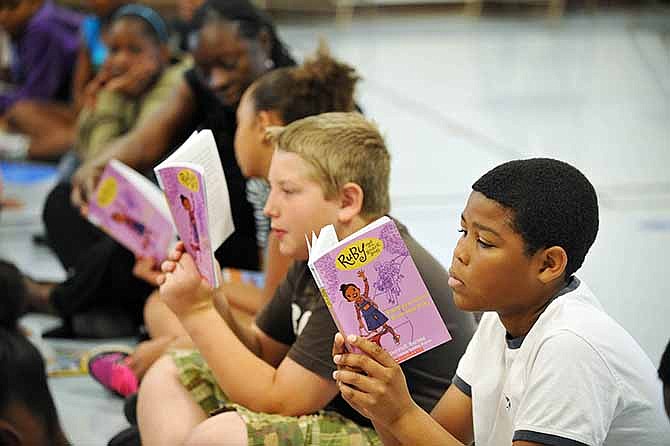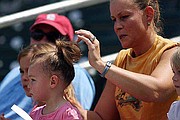In 1972, this newspaper asked the question: "Is East School at the "bottom of the list' among local schools and should a new elementary school be built in the East End?"
Forty-two years later, the Jefferson City neighborhood still lacks a new school, and some people still are ringing alarm bells over the plight of East Elementary students. Back then, people were concerned the ratio of students per square foot at East School was nearly double that of most of the city's other elementary schools.
Today, statistics maintained by the Missouri Department of Elementary and Secondary Education tell a story about an embattled school community coping with some of central Missouri's toughest socioeconomic conditions. The numbers paint an anxious picture and pose a difficult question: Do some of the city's most-disadvantaged kids attend class every day in the district's most-decrepit structure?
Standardized exams reveal East students' academic struggles.
East Elementary earned a 52.9 score - the lowest in the district - on its 2013 School Annual Performance Report, a tool the state uses to evaluate academic and attendance levels. Nearly half of the school's students scored at the "basic" or "below basic" levels in language arts. One in three East students is "proficient" or "advanced" in science.
The school also has the highest number of students - 87 percent - who qualify for free- and reduced-priced lunches. That figure is nearly double those of other schools in the JCPS district, such as North Elementary (43.8 percent) and Cedar Hill Elementary (42.6), according to DESE.
Now 75 years old, East Elementary's facilities also have been deemed lacking.
Last fall, the Board of Education hired Kansas City-based firm ACI Boland Architects to conduct an appraisal study of 18 facilities within the district. After undertaking walk-through tours and holding discussions with building administrators, the team evaluated the buildings in six categories.
East Elementary received an overall score of 57.4, putting it in the "borderline" category - below "satisfactory" or "excellent."
According to the architects' analysis, the school's gymnasium, outdoor facilities, administrative offices, clinic space, reception space and art facilities were rated "very inadequate." They gave a similar rating for the building's acoustical treatment of ceilings and walls for effective sound control. They noted that emergency light fixtures in the original building are limited and that the psych examiner's office is in the second-floor elevator lobby, a space that is also used for occupational and physical therapy and that does not have air conditioning.
They rated the school "poor" for not being free of friable asbestos and toxic material; not having enough adequate parking; not having good access to drinking fountains; not having enough custodial storage space; and not being suitable for outdoor learning. They noted the school has no grassy play areas.
The building also received quite low marks for safety and security, earning "poor" ratings for failing to segregate student loading areas from other traffic and for lacking a security system that ensures the uninterrupted operation of the educational program. The report also noted that not all glass is properly protected to prevent accidents.
They rated the building's ventilation system "poor to borderline" for its ability to offer adequate, quiet circulation of clean air and comfortable temperatures and humidity levels.
The report also rated as "borderline" the placement of fire safety equipment, number of independent exits, use of fire-resistant materials and emergency alarm system. The building also lacks a fire-sprinkler system.
The architects' report noted that the school lacks a commons area capable of enhancing communication among students, or space suitable for separate age groups.
East is also the only school with a trailer; the building houses the school's reading recovery program.
What should be done?
Although advocates for the city's East End long have been concerned about the school, the architect's report recently galvanized concern about the building. Former Jefferson City Mayor John Landwehr, who grew up and still lives on the city's East Side, has become an advocate for improving the school.
He sees a connection between the school's challenging demographics, its outdated facility and its lackluster academic performance.
"The first step is for the school board to acknowledge the correlation between these three factors - how they drive each other," he said. "Professional educators have known for years that having a balanced socioeconomic student population is critical to student success."
Landwehr argued the "evidence is irrefutable that poor students at mixed-income schools perform better than when they are kept in high-poverty schools."
He added: "We also know that substandard facilities adversely impact morale and send a message to students and parents that this school is not important.
"If they can, families move away from schools with substandard facilities."
He would like to see the board improve East School's facilities, but feels it's "more important" for the Board of Education to adopt a policy of socioeconomic balancing of all student populations.
"Other districts do this routinely. It will take work, but we can turn this around," Landwehr said.
Such thinking isn't a foreign concept to the Capital City, he said. "It was an expressed ... selling point when the two middle schools were being promoted" nearly 25 years ago, he noted.
Superintendent Brian Mitchell said addressing East School's needs was on the Board of Education's mind when they asked voters to approve a new elementary school a year ago. Faculty and parents were thrilled when the board proposed the bond issue.
"We were really excited about having a new building on the bond issue, and we wanted so badly for it to be passed ... just because of that feeling of walking into anything new - whether it's a new house or a new car - makes that pride level go right up. And we knew it would for the kids, too," said Principal Julie Martin.
However, the elementary request became ensnared in the new replacement high school proposal, did not garner much public attention, and failed with voters last April.
Plans for a new elementary school on the city's East Side have been in works for decades. The school board purchased land for a school in 1967, but sold it five years later. At the time, school leaders said the student enrollment numbers were leveling off and a bond issue would be a hard sell.
Landwehr sees that action as the first in a series that led to today's situation.
"The present board had no part in that 1972 decision," he said. "But it is their responsibility to address its long-term effects."
Three years ago, under Mitchell's tenure as superintendent, the board purchased a site - located between McCarty Street and Lewis and Clark Middle School - to build a new East Elementary. It's still waiting for voters to approve a school there.
Now an option being considered is to devote up to $2 million to renovate East Elementary during the summer of 2015, Mitchell said. (Each year the district allocates about that much money to renovate one of its facilities. South Elementary was overhauled last summer and West Elementary - which is the same age and has the same floor plan as East - is slated for this year.)
One challenge facing the district, said Mitchell, is that the community may not be aware of the poverty afflicting all of the schools, not just East. The number of families qualifying for free- and reduced-priced lunches has been rising district-wide in recent years, he noted.
Today, more than half of the district's families qualify.
"We have to understand poverty and the impact it has on the learning process," Mitchell said.
Although the district generally works to treat all the elementary schools equally, East "has had intensive support," Mitchell said, noting the school, because of its status, has more federally funded Title I staff than other district schools.
"We have three and a half reading teachers at East, more than at the other elementaries," he noted. "There is some intensive reading support at East."
Teachers at the school gave up their evenings to undergo professional development training in order to earn an E-MINTS grant that provided computers for third-, fourth- and fifth-graders. "We have a lot of technology at East," Mitchell said.
But he added: "Money is not always the answer."
"It's just hard work," he said, noting that hard work involves teachers taking advantage of professional development opportunities to master the best instructional strategies and best use of technology.
"We're going to ensure that all of our kids perform at the highest levels, and we have to have community and family support," he said.
On the plus-side, East has some of the lowest student-to-staff ratios in the district; the teachers generally have a few years' more experience and tend to have earned more professional degrees than those at other district schools.
"I would put my kids in East, and I would not have any concerns about them being there," Mitchell said. "We have as fine a staff at East Elementary School as we do anywhere."
Martin reiterated Mitchell's faith. She noted many on her faculty are veteran teachers who feel a special calling to help kids.
"In their heart of hearts, they know kids can learn, no matter what, and they do their very best job to keep them growing. Wherever they start from, we want them growing to the next level," she said.
She noted that kids living in poverty face a different set of daily issues. "Some of those basic needs that we take for granted, they don't necessarily take for granted," she said.
The school offers a free breakfast program to every child in the school - one way of making certain no one is trying to learn on an empty stomach.
Mitchell noted the socioeconomic issues at East School extend beyond factors controlled by the Board of Education. For example, he noted that social services - such as the Samaritan Center and the Boys and Girls Club - are located on the East Side.
"You're going to have a concentration of people in lower socioeconomic circumstances around those facilities," Mitchell said.
Both Landwehr and Mitchell say East Side neighborhoods have been casualties of urban sprawl, victimized by outmoded zoning and land-use policies, by a reluctance to call absentee landlords to task and by regulatory attitudes that drove developers away.
"School leaders and city leaders did not implement measures to preserve and protect older neighborhoods," Landwehr lamented.
The former mayor lamented that often public amenities like schools are built with no urban planning analysis at all.
"In the end, the issues at East School are not just school board issues. They are community issues. But the school board must take the lead since a vibrant elementary school is the anchor to neighborhood integrity," he said.
Landwehr does not attribute the school's failure to a lack of effort or empathy on the part of school leadership or personnel. "Dr. Mitchell has been a breath of fresh air, and the current school board has tremendous character," he said.
Where the two men differ is in their approach.
Landwehr is advocating an approach that will require rebalancing all the elementary school boundaries to achieve districts that are more alike in terms of the household income. The term "socioeconomic status" refers to the combined total measure of a person's work experience and economic position, based on income, education and occupation.
He noted that East School's boundary crosses a "natural" boundary - Highway 50 - to include a section of low-income Housing Authority apartments.
Mitchell - whose staff would be tasked with identifying and proposing the redistricting changes - said the task is not so easy.
"I don't mind talking about boundary changes," he said. "But if we are really talking about balancing the demographics of the school district, you're going to have to move a significant percentage of our students from their current buildings to new ones."
Mitchell warned it could mean students "bouncing" between schools to maintain that balance over time. Or, the district could bus children, which would be expensive. "And then you get away from the concept of neighborhood schools," the superintendent added.
Board of Education President Tami Turner said she would be willing to talk about school boundaries if Mitchell thought it would be beneficial to student performance. "It's definitely something I would consider," she said.
The superintendent added the idea that buildings ought to be balanced is not identified in the district's strategic plan or in board policy.
"East just happens to be the poster child for what happens where there are no policies in place," Landwehr said.
He suggested boundaries should be redrawn for all schools every five years to reflect population trends and area growth.
"Practically every other school district in the state redraws boundaries on a regular basis. Columbia does it every couple of years. Once residents understand the district will no longer create "poor schools' and "rich schools,' they will decide where they want to live based on other factors instead of which grade school is perceived as successful," Landwehr said. "All the well-intentioned buddy packs and mentors in the world are not going to fix this problem."
Many leaders in the district, including Mitchell and the Board of Education, are currently poised in a wait-and-see posture until an appointed group - the Long Range Facilities Planning Committee - comes back with suggested solutions for the district's future. Mitchell appointed the group to create a 20-year plan for future facilities planning.
The group currently is meeting monthly to talk about how to address problems of overcrowding at the high school, while also trying to rank the needs of elementary and middle school students.
Whatever that committee decides, it's likely to carry some weight, school leaders have vowed. "The board is all in agreement that we want to support the committee's recommendations," said Turner.
Asked if it would be better to solve the high school's overcrowding issues before broaching another potentially contentious issue, Landwehr indicated the district should move forward.
"I don't think the concept of providing equal education opportunities for kids is contentious," he said. "The majority of schools in the state already do this. Our middle schools do this."
Landwehr added: "I think when you have three or four big issues or problems, you have to work on them all. In fact, the issues are often co-related.
"Interestingly, adopting a policy of socioeconomic balancing takes no money and no election campaign. It just takes courage. I'm confident (the superintendent and the board) can address these issues in a way that will be embraced by the community."
A longtime city leader, Landwehr also sees too many "leadership silos" in the community.
"The school board, the city council, the county commission and private groups like the YMCA and churches should start talking more about long-term goals for the community instead of everyone just looking at their own agendas and very short-term horizons," he suggested.



